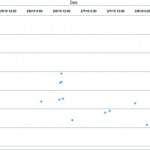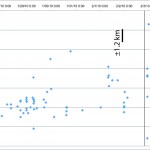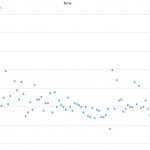earthquake
The Great Earthquake Swarm at Yellowstone that ushered in 2010 seems to be dying down, at least according to the USGS earthquake reports and analysis of the seismicity by the University of Utah and YVO. The daily updates on the earthquake swarms by Utah has ended. Looking at the earthquake over the last 7 days (see below), you can notice three things quickly: (1) since 2/6, there are much fewer quakes compared to a week and a half ago; (2) any sign the earthquakes were getting shallower seems to have ended; and (3) they seem to be generally smaller ( M1.5). Now, what does that mean? Like many…
News!
Pakistan is home to the world's tallest mud volcano in the region of Balochistan - and its somewhat near the reports of an "eruption" earlier this week.
Guess what? Since Wednesday evening, seismicity at Yellowstone has dropped precipitously. The last batch of earthquakes on February 3rd were also back to deeper levels - 8-9 km depth - compared to the potential shallowing earlier in the week. I'm sure the caldera will keep us on our toes, but as of now, it seems to have settled down a bit.
Over in Pakistan, there is mounting evidence that the recent "volcanic" eruption reported as, in…
With all the talk of the current Yellowstone earthquake swarm, I thought it would worth it to write a post on the the structure and caldera - and why we get earthquake swarms that are structurally rather than magmatically-related.
First off, lets think about why calderas formed. This is relatively simple - at least superficially. The land (or volcano) above a magmatic system is partially supported by that magma, especially because magma is hot and buoyant. The isostatic support by the magma holds up the land surface or volcanic edifice, so when an eruption expels a large volume of magma, this…
Steaming, gurgling mudpots in the active hydrothermal system of Yellowstone.
For those of you following Yellowstone (I think there might be a few of you), I've plotted up the earthquakes since 1/27 (see below) - and sure enough, although there is a lot of scatter, they are getting shallower - however what this exactly means is unclear. You can see my plots from 1/22-28 here. As many of you have mentioned, a caldera like Yellowstone is a big interconnected system, so a solely tectonic source of this is still possible as the displacement migrates through the fractured caldera rocks.
UPDATED…
First off, I wanted to thank all of the Eruptions readers for making January the most popular month ever on this blog. I suppose I should give an assist to Yellowstone, but really, thanks for coming to the blog, reading the posts and engaging in all the great discussions that go on within its (cyber)walls.
KÄ«lauea's east rift zone eruption site. Image courtesy of the USGS/HVO.
On to some news!
I suppose you've made the big time when you're in the New York Times, and sure enough, the current Yellowstone earthquake swarm is in the Old Grey Lady. Nothing much new to read, but summarizes the…
Some news for the last Friday in January:
Volcanic lightning captured over Redoubt in March 2009.
Tungurahua in Ecuador continues to erupt. Yesterday, the volcano spread ash over much of central Ecuador. Apparently people in Ecuador aren't taking the hazard of ash too seriously, with many ignoring recommendations to wear masks when the ash is falling. Over 50 explosions have been recorded over the last 24 hours at the volcano according to the Ecuadorian Instituto GeofÃsico, most of them small to moderate.
We also have a new USGS/Smithsonian Institute Volcano Activity Report. Much of the "…
There has been a ... ahem ... healthy discussion of Yellowstone's current earthquake swarm on Eruptions as of late. We've now reached ~1,500 measurable earthquakes over the last 11 days. The latest reports of the continuation of the swarm isn't going to make anyone happy, but still, there are no signs that (a) this is out of the ordinary and (b) indicates magma making its way to the surface. In fact, if you plot the earthquakes since the 22nd of January, the depth appears to getting, well, deeper:
This plot shows the earthquakes listed on the USGS earthquake page since January 22 (oldest to…
Old Faithful geyser at Yellowstone National Park.
A few thoughts about faulting, earthquakes and eruptions:
The earthquakes at Yellowstone have been universally attributed to fault movement rather than magmatic activity by the USGS and the researchers at the University of Utah. This is likely based on the moment solutions for the earthquakes (i.e., the sense of motion on the earthquake - side to side, dilation, etc.) and the fact that there are no directly correlative volcanic/magmatic symptoms to go with them (such as pronounced, short-term bulging, excessive hydrothermal venting, etc.) Now…
Two quick notes:
A Costa Rican farmer evacuating in early January 2010 after renewed activity of Volcan Turrialba.
Well, it appears that after a quiet night on Friday, the current Yellowstone swarm picked up where it left off. We're now up to 1,200 earthquakes since January 17th, with a pair over M3 today. Of course, people are still uppity about the swarm, especially after the earthquake in Haiti, but really, they're about as connected as worrying about the rainy day in Boston when there was a typhoon in Malaysia. Just to get people on the same page, YVO still says: "The swarm events are…
Outcrops of Obsidian Butte, California, near the Salton Sea.
A brief update on the two earthquake swarms making news right now:
Yellowstone
The earthquake swarm at Yellowstone is still rumbling along, reaching over 1,000 earthquakes measured over the last week. However, the swarm has begun to die down overnight - with no earthquakes between 10:41 PM (MST) on 1/22 and 6 AM on 1/23. However, although this is a longer, bigger swarm than normal, it still isn't out of the regular rumblings at Yellowstone caldera. The USGS continues to say this swarm is tectonic, rather than magmatic or…
Small earthquakes in unexpected locations are often a cause for concern. The worry is that these rumbles are harbingers of bigger quakes to come. But not always - a new study suggests that many of these tremors aren't warnings, but aftershocks. In particular, those that happen in the middle of continents, far away from the major fault-lines that separate tectonic plates, probably reflect past quakes rather than future ones.
Earthquakes are a common occurrence on the boundaries between tectonic plates, and they occur at predictable spots. But they can often strike areas that are far away from…
In the wake of Monday's earthquake in the L'Aquila region of Italy that killed over 200 people, news emerged that one Italian scientist had predicted the earthquake less than two weeks earlier. Giampaolo Giuliani's predictions were broadcast on March 28 but was dismissed by Italian authorities--and rightly so, according to ScienceBloggers. The radon-measurement technique Giuliani based his prediction on has proven to be unsuccessful in the past. "Any geologist would be celebrating a genuine, proven, method of earthquake prediction," said Chris Rowan of Highly Allochthonous, "but we're clearly…
Well, technically this is Friday tsunami blogging, but sometimes it's hard to tell the difference. Yesterday was the 50th anniversary of the 1958 Southeast Alaska earthquake and ensuing Lituya Bay megatsunami, a half-kilometer high wave which killed only a handful of people.
The earthquake happened on the Fairweather fault, a strike-slip fault which forms the main boundary between the Pacific and North American plates on the Alaska panhandle. Strike-slip earthquakes don't typically cause tsunamis directly - in a strike-slip event, the ground moves mostly horizontally, not vertically, so it…
Earthquake engineer Kit Miyamoto has posted a journal of his trip to Sichuan. If you don't mind a little bit of construction jargon it's a good discussion of the details of what kinds of buildings collapse, and what kinds are safe, as well as the logistical difficulties of the immediate post-earthquake recovery. The lesson to be learned from the Sichuan earthquake is the same as the lesson of basically every major earthquake in the past several decades: If you build bad buildings, they will fall down and kill people.
After some earthquakes, we have been able to dramatically improve our…
What makes earthquakes? Although there are many causes, including volcanoes, the most common thing that causes them are tectonic motions, which also cause tsunamis. But as valuable as it is to understand other planets in our solar system and in other star systems, sometimes it's important to understand what's going on inside our own planet.
The crust of the Earth actually is made up of a number of plates, which rub against one another and move over time. Who's to blame? I fault the liquid hot magma.
So what happens is that these plates slip against each other in one of three ways, as shown…
tags: earthquakes, tsunamis, geology
I carefully follow the news of Indonesia and other places in the South Pacific Ocean because that's where my research birds come from. So I was listening to radio reports of the recent spate of Sumatran earthquakes with great concern, worried that yet another tsunami would result. But as I listened to these reports, I noticed something else that was unusual; the reporters referred to multiple earthquakes occurring in the region, rather than one quake that was preceeded by foreshocks and followed by aftershocks. So of course, I had to ask the resident…



